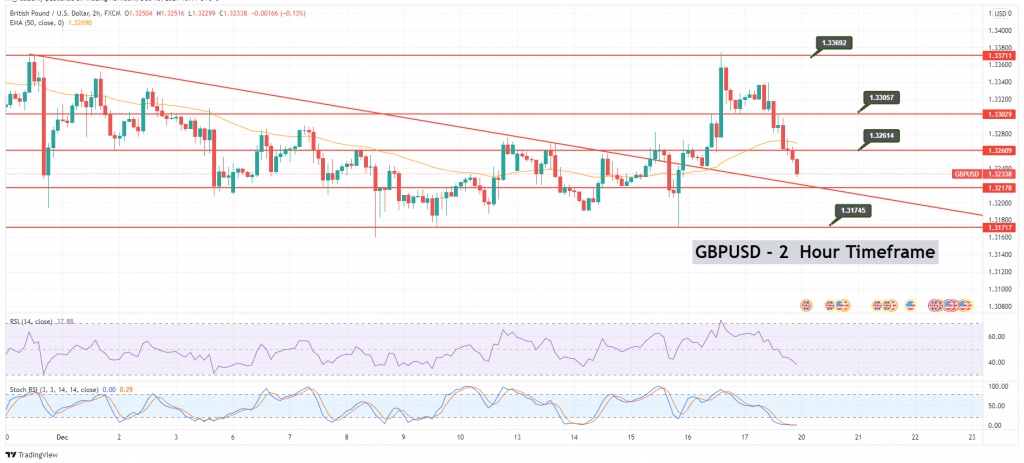Bank of England (BoE) Hikes Policy Rate to 0.25% – Watch out GBP/USD
Please note that we are not authorised to provide any investment advice. The content on this page is for information purposes only.
- The Bank of England (BoE) raised interest rates from 0.10% to 0.25% on Thursday.
- GBP/USD dropped after rising for three consecutive days amid the rising strength of the US dollar and Omicron fears in the UK.
- A spike in selling pressure could trigger a selling trend until the 1.3210 and 1.3170 levels.
The BoE has become the world’s first major central bank to do so since the coronavirus pandemic wreaked havoc on the global economy. The BoE also warned that inflation was expected to touch 6% in April, three times its goal level. On Thursday, the Bank of England (BoE) raised interest rates from 0.10% to 0.25%. On Friday, the GBP/USD closed at $1.3242 after hitting a high of $1.3376 and a low of $1.3240.
Refer to our trading guides to enhance your forex trading skills.
A stronger dollar drags GBP/USD lower despite the BoE rate hike.
The GBP/USD dropped after rising for three consecutive days amid the rising strength of the US dollar and Omicron fears in the UK. The US greenback, which measures its value against a basket of six major currencies, broke its two-day bearish streak and moved higher on Friday, closing at 96.69. The US dollar gathered strength due to its safe-haven status amid omicron fears affecting economic recovery.
A quick economic outlook
On the data front, at 05:01 GMT, GfK Consumer Confidence in Britain dropped to -15, against the projected-17, and supported the British Pound. At 12:00 GMT, retail sales had increased by 1.4%, compared to the predicted 0.8%, bolstering the pound. The British Pound’s positive impact on the British Pound capped a further decline in GBP/USD.
Furthermore, the US dollar was also high on the board after the positive comments from Fed Governor Christopher Waller. He said a rate hike might be warranted soon after the Federal Reserve ends its asset purchase tapering in March 2022. He further called March a “live meeting” for a rate hike, which added strength to the US dollar because a timeline for the rate hike was provided in some manner. The currency pair GBP/USD was further weakened by a strong US dollar.
A surge in COVID-19 cases highlights
The UK has recorded an additional 93,045 coronavirus cases, making Friday the worst day yet of the pandemic. On Friday, the country confirmed about 15,000 cases of the Omicron variant and weighed on the British Pound, which ultimately dragged GBP/USD to the downside.
Daily coronavirus infections were reaching their highest level on record in the UK, causing British businesses to shut down their doors again despite no announcement of restrictions from the government. Restaurants and bars in the UK decided to close early for Christmas due to a rising number of cancelled reservations and concerns about the health of their staff members.
After seeing three record-breaking days of the highest number of coronavirus cases in the pandemic, the UK’s PM, Boris Johnson, was facing mounting pressure to act, and he decided to hold an emergency COBRA meeting this weekend. The Omicron concerns, Brexit issues, and the US dollar’s strength kept GBP/USD lower on Friday, whereas the UK GDP data and the latest decision to hike interest rates by the BOE limited the additional losses in GBP/USD.
What happens next after the BoE raises interest rates?
Surprising traders for the second time in six weeks, the Bank of England (BoE) said it needed to intervene now, despite the spread of the Omicron coronavirus type, because it detected warning indications of underlying inflation pressures. The Monetary Policy Committee voted 8-1 to hike the bank rate from 0.1 percent to 0.25 percent, with external member Silvana Tenreyro casting the lone dissenting vote.
Governor Andrew Bailey stated that Omicron was already causing problems for stores and restaurants, but the BoE felt forced to prevent the latest price increase from becoming a longer-term issue. Because of the Omicron variant, which increased COVID-19 cases in Britain to a record high on Wednesday, most economists polled by Reuters predicted the BoE would retain the bank rate at 0.1 percent.
The Bank of England forecasted more “moderate tightening of monetary policy” over the next three years, while inflation might be less or stronger than predicted. Investors rushed to fully price in another bank rate increase, to 0.5 percent by March and 1 percent by September.
On Thursday, the BoE’s rate hike put it ahead of the US Federal Reserve, which announced on Wednesday that it was speeding up the phase-out of its bond-buying stimulus as the first move toward perhaps three interest rate hikes in 2022. The European Central Bank and the Bank of Japan are moving away from raising interest rates. The ECB reduced its stimulus even further on Thursday but guaranteed considerable support for the eurozone economy in 2022.
Omicron’s short-term impact and BoE projections
Considering Omicron, the BoE reduced its growth expectations for December and the first quarter of 2022. Omicron might result in a very high number of infections over a relatively short period. A survey of purchasing managers conducted earlier on Thursday revealed that hospitality and travel companies have taken a hit this month. Omicron has caused a reduction in private sector growth to a 10-month low. However, the Bank of England also stated that Britain and the global economy were in a “materially different” situation than at the outset of the pandemic, with inflation now high.
It emphasized the “upside risks” associated with salary trends. There was no evidence of a rise in unemployment following the end of the government’s job-supporting furlough scheme on Sept. 30. However, the BoE said it now expects Britain’s unemployment rate to decrease to approximately 4% by the end of the year. It’s down from 4.5 percent barely a month ago.
According to data released earlier this week, the rate was 4.2 percent in the three months ending in October. This year, British firms have suffered acute staff shortages due to Brexit. This has compounded the loss of foreign workers caused by the epidemic last year. The MPC decided 9-0 to keep the central bank’s government bond-buying program at the 875 billion pound ($1.16 trillion) target size. The Bank of England has also purchased 20 billion pounds of corporate bonds.
GBP/USD daily technical levels
Support Resistance
1.3248 1.3384
1.3176 1.3448
1.3112 1.3521
Pivot Point: 1.3312

GBP/USD slips to $1.3235 despite the BoE rate decision
The GBP/USD price forecast continues to be bearish despite a surge in the BoE interest rate. The GBP/USD pair spiked to retest the 1.3370 resistance level. However, it failed to crossover. Thus, the candle closing below this level triggered a sell-off in Sterling.
In the 2-hour timeframe, the GBP/USD has closed a “Three White Soldiers” pattern. Typically, such a pattern signals a strong selling bias in the market. Therefore, the odds of a selling trend continuing to dominate the market are high.
On the bearish side, the GBP/USD’s significant support prevails at 1.3220. A break below this level exposes the GBP/USD price towards 1.3170 and even lower towards the 1.3135 level.
Conversely, a spike in bullish pressure can slice through the 1.3260 hurdles. The price can move to the next resistance level at 1.3305. A break over 1.3305 will allow the next resistance mark test at 1.3370. A further upward breakout could extend the buying trend to the next resistance level at 1.3370.
The leading technical tools like the RSI and Stochastic RSI hold below 50, indicative of a selling trend. Moreover, the recent bearish crossover below the 50-day exponential moving average also supports a selling trend in the GBP/USD. Therefore, a spike in selling pressure could trigger a selling trend until the 1.3210 and 1.3170 levels. Good luck, and stay tuned for more updates!





